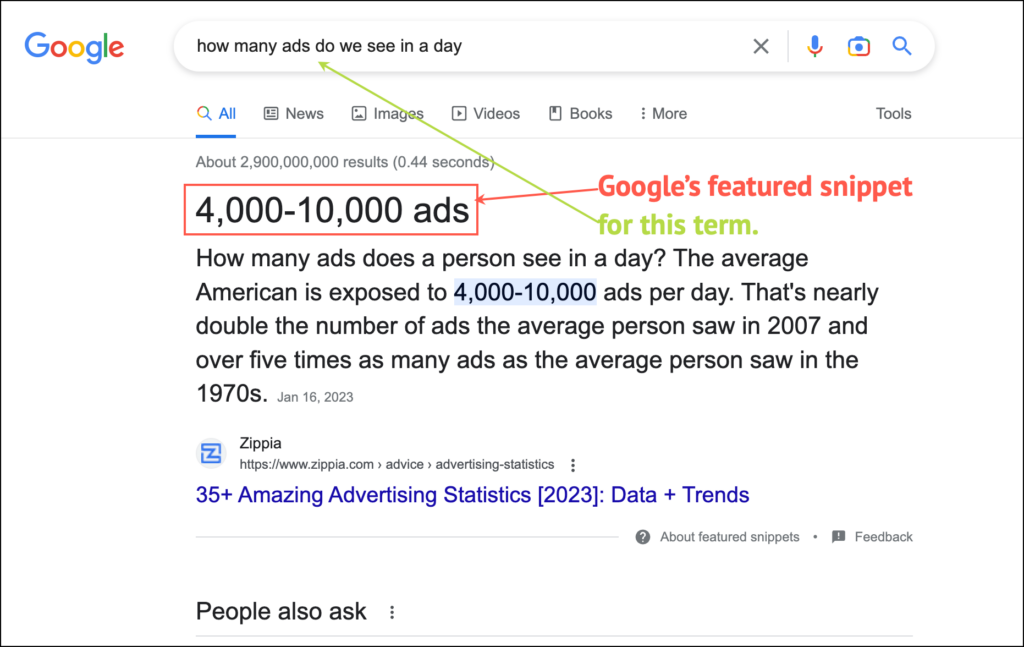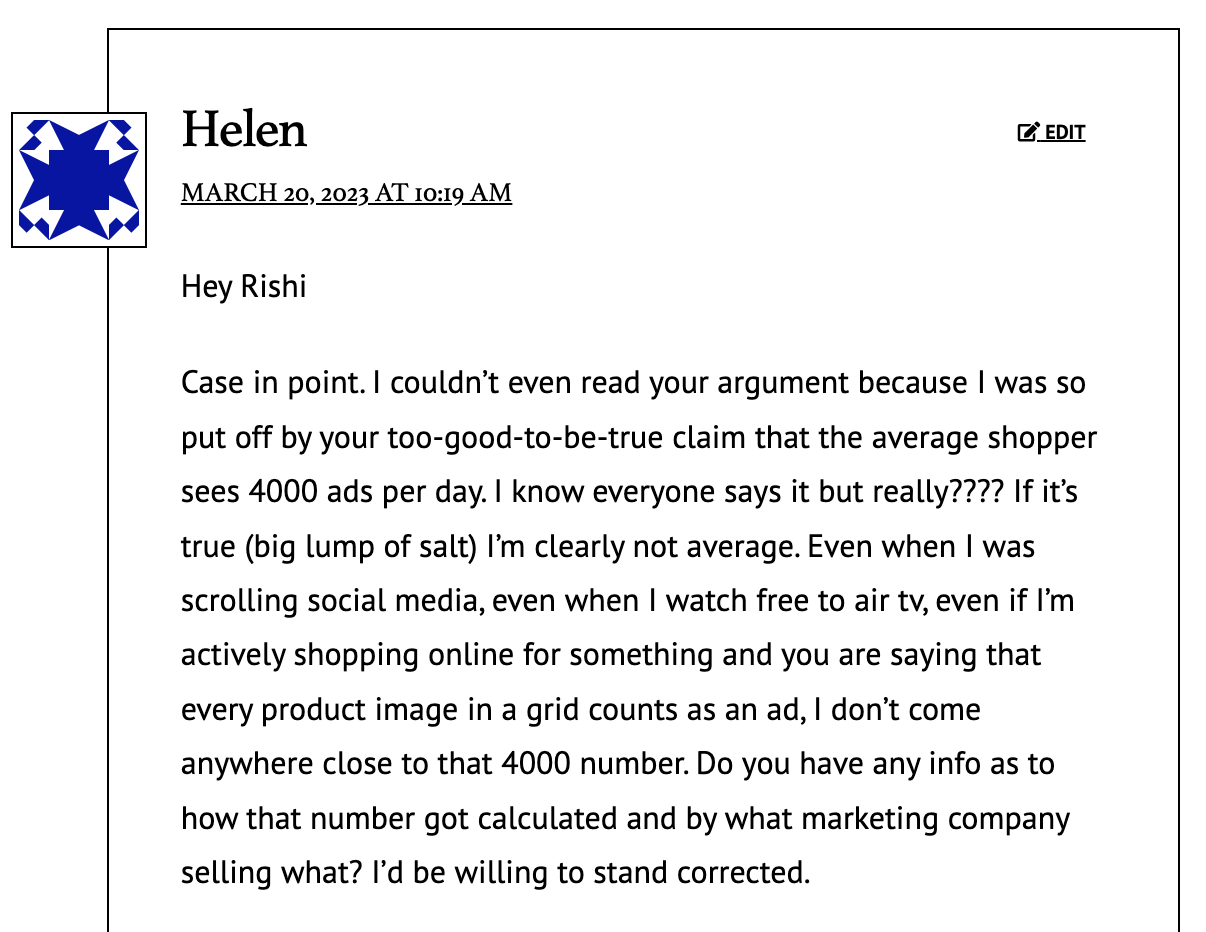Blog
Fact-Checking — How Many Ads Do We See in a Day?
Summary:
- The number you’ll find on is a 2015 stat of 4,000-10,000.
- All articles (except this one) are based on that number.
- A potentially better metric is to look at banner ads.
If you Google how many ads do we see in a day? you are going to see a crap ton of articles that seem to reference the same number. Even the featured snippet on Google shows this range:

But Is This 4,000-10,000 Ads Stat Correct?
It turns out all of these articles (including mentions in Forbes) are from a Red Crow Marketing article by Ron Marshall.
My Opinion
I have found this number problematic for a few reasons:
— It’s from 2015
— It’s a wide 6,000 range. When using it, should I use the upper or lower range of the stat?
— The Red Crow Marketing doesn’t link back to a parent source with more context on this How Many Ads Do We See in a Day? topic. The article is just a summary of Ron’s personal experience. And while I think Ron was very careful in how he recorded his exposure to ads, I needed a more dependable number if I could find one.
Why I Care
My name is Rishi Rawat, and I’m a marketer who uses words to convince and convert shoppers who are buying from a brand for the very first time. I’ve been writing about marketing and conversion strategies for the last 16 years. I liked the idea of using a number to communicate how many ads people see in my article because it allows me to make a bigger point about why brands need to do a much better job presenting a pitch to convert visitors to their site.
But the 4,000-10,000 ads stat wasn’t definitive enough.
Hunting down the true number (or a number I can actually cite and use) isn’t something I’ve been interested in doing in 2025; it’s been something I’ve periodically Googled for the last 5 years. But like most searchers, I click through to a few articles, don’t see anything new, and end my search. I seldom go beyond page 2 of Google results.
And Then I Got into Trouble
I have a weekly newsletter, and for my latest article, I was trying to add some dramatization to a point I was making, so I started the article with this line:
The average shopper sees 4,000 ads in a day.
And boy was that a bad idea because 4 hours after hitting send, I got pushback. Here’s the actual comment:

I’m going to level with you—Helen’s comment stung because she was right. I had been irresponsible in my use of that 4,000 number.
So I spent the next 2 days hunting down this bloody number.
I was hoping for some concrete data but got a few anecdotes. Useful anecdotes but nothing that would satisfy the Helens of this world.

Shifting Focus
I first started with Google Scholar, Google’s academic paper search engine. Quite surprisingly, I couldn’t find one academic paper on the topic … or I’m terrible at searching. Both are possible.
Then I changed course and asked, “What for-profit business type would most value this number? Whose financial future depends on it?”
Online publishers depend on ad revenue.
Here’s what I learned:
—In 2021, digital display advertising in the US was $92.53 billion.
— The cost-per-thousand impressions or CPM for Google’s Display Network (GDN) was $2.80 in 2018 (source).
— Here’s the math. If $2.80 generates 1,000 ad impressions, then the cost per impression is $2.80 / 1,000 = $0.0028. If I pay $0.0028, I get 1 banner ad impression. If I pay $92.53 billion (that’s how much publishers were paid in total for banner ads), I’ll receive $92,530,000,000 (92.53 billion) / $0.0028 = around 33,000,000,000,000 banner ad impressions.
— In the 🇺🇸, there are 258,000,000 people who are above the age of 18 (source).
— This means the average person is exposed to 33,000,000,000,000 / 258,000,000 = around 127,000 ads per year on just publishing sites.
— There are 365 days in a year, so this comes out to 127,000 / 365 = 347 banner ads per person per day.
Now, this number is only looking at publishing sites. We don’t just see ads on publishing sites. We also see them on the TV, on buses, during our morning walks, while we’re listening to Joe Rogan’s podcast, when we’re watching YouTube, on Twitter, and on Facebook.
The average American spends 7 hours looking at a screen each day (source). They certainly aren’t spending all that time on publisher sites, which means they most likely are exposed to way more than just the 347 ads we calculated above.
This infographic from Gradschools.com does a good job showing just how many ads we’re exposed to on the daily.
But to make Helen happy and avoid the temptation of overstating the number. Let’s just say the average American is exposed to 347 ads a day.
Why This “How Many Ads Do We See in a Day?” Question Matters
The question brings into focus what brands are competing against. The reality is that there is no way for shoppers to process this much incoming advertising. So, our brains have developed clever little tricks to filter out the noise. But could it be that your message is also getting crushed in this mass filtering that’s going on? It’s likely.
I’m going to teach you a technique that none of your competitors know about and one that’s guaranteed to massively impact your conversion rates.
Most people on your site aren’t going to buy. Our strategy is to ignore 80% of site visitors so we can triple down on a very narrow segment 👈🏼 Click that link to radically enhance your eCommerce site.





Comments 9
Rishi, There are 365 days in a year (not 356). Only slightly different result. Interesting way of coming to an ads per person per day number. I probably saw that many in Instagram this morning alone!!
Hope you’re well!!
Take care, John
ReplyRishi Rawat
John, is that really you? Man, it’s been a long time. Also, you are spending way too much time on Instagram.
And yes, I got my math wrong. Fixed.
Replyi have an extremly specific assignment and this was helpful, thank you exclamation point and heart emoji
ReplyLove this article! I’ve been doing kind of the same calculation as you, and figured out that an average Norwegian human being is exposed to around 420 ads each day. So, I’m glad to see your numbers are in the same range 🙂 Thanks!
ReplyRishi Rawat
Hey, Mats. You’re right, our numbers are very close!!
ReplyThis is definitely helpful. The 4,000-10,000 figure has become an urban legend, and when you think about it, probably doesn’t get internalized and mentally processed. It doesn’t get thought about, just repeated. Thanks for what seems to be the most definitive # we have. But there’s more to it than just being exposed to ads, most of which are mental litter. It’s the entire worldview they represent. The products may make us salivate, cower, or fight, but it is the consumerist perspective that we are infected with. I can’t imagine why a decent person would be in the public relations/advertising business. There is so much need in the world, why would anyone want to sell bullshit. Read the first sentence of Edward Bernays’ _Propaganda_, the classic of Modern pr/advertising. The fact that manipulation is the life of such a career is pitiful. It is the opposite of liberation.
ReplyRishi Rawat
Morning, Richard. Thank you for that thought-provoking message to start my week. First, you are correct that the number I am showing in the article is a conservative estimate, meaning the number of ads we are exposed to is far in excess. But I feared that if I tried to make the number bigger than whatever evidence shows, people would criticize me for sensationalizing something, even though I don’t think a number that was 50% higher would in any way be an exaggeration.
Now, let’s get to your second point in your comment: why would someone ever want to get into the world of PR or advertising? This is a more complicated question because I am in the world of Marketing and share your sentiments. In fact, one of the things that I have suggested as a thought experiment is that marketers, like physicians, should have to take their version of the Hippocratic oath. This is a dramatic way of acknowledging our moral responsibility not to mislead the shopper. There isn’t anything inherently wrong with the profession as long as the scope of the work is limited to finding interesting ways of grabbing the shopper’s attention and talking truthfully and interestingly about the product they are selling.
Replyty for your work!! i wish more accurate info like this was at the top when searching for it, i was also skeptical of the 4,000-10,000 mark.
ReplyRishi Rawat
Hi, there. Glad you found the article useful. I wrote it specifically for people that were skeptical about the 4,000-10,000 number. Glad you found it.
Reply